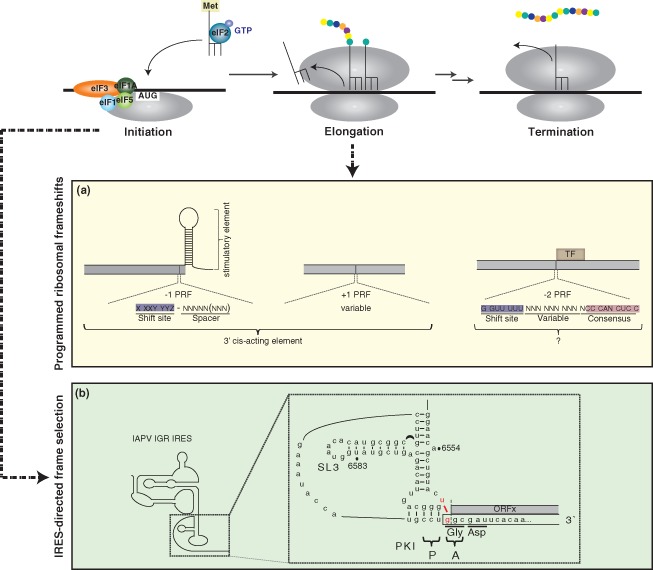Figure 6.

Increasing coding capacity by programmed ribosomal frameshift elements and IRES‐mediated translational reading frame selection. The translation cycle involves the steps of initiation, characterized by the recruitment and positioning of the ribosome at the translational start site; elongation, where amino acids are sequentially added to the growing polypeptide chain; and termination, where the nascent polypeptide is released from the ribosome. Programmed ribosomal frameshifts (PRFs) act on an elongating ribosome whereas translational reading frame selection mediated by the IGR IRES occurs at the level of initiation. (a) Three types of PRFs, including the −1, +1 and −2 PRFs, have been identified in various viral genomes. In the −1 PRF, the frameshift site is comprised of a heptanucleotide sequence with the consensus X_XXY_YYZ (where X represents any nucleotide, Y represents A or U, Z represents A, C, or U, and the underscores designate the codons in the 0 frame) and a downstream spacer sequence. While the consensus for −1 PRFs is well characterized, the frameshift consensus in +1 PRF is more variable. −1 PRFs require a 3′ stimulatory element and +1 PRFs depend on cis‐elements that facilitate the displacement of the ribosome into an alternate frame. The −2 PRF, recently identified in the arterivirus porcine reproductive and respiratory syndrome virus, produces a transframe fusion (TF). The −2 PRF occurs at a conserved G_GUU_UUU sequence and is stimulated by a conserved downstream CCCANCUCC motif located 11 nucleotides downstream. The mechanism of this mode of frameshift has not been fully elucidated. (b) Israeli acute paralysis virus (IAPV) IGR IRES‐mediated translation in the +1 reading frame occurs via a U:G wobble (highlighted in red) adjacent to the IRES translational start site. The first amino acid decoded in the +1 frame is alanine. Mass spectrometry analysis has identified the presence of ORFx in virally infected honeybees, although its role in virus infection is currently unknown. (Reprinted with permission from Ref 147. Copyright 2012 Elsevier Inc.)
